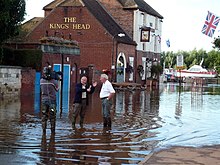
Back Llifogydd Canolbarth Lloegr 2007 Welsh Inundaciones en el Reino Unido de 2007 Spanish Britannian tulvat 2007 Finnish Overstromingen in Groot-Brittannië 2007 Dutch Oversvømmelsene i Storbritannia i 2007 NB Наводнение в Великобритании (2007) Russian 2007 United Kingdom floods SIMPLE Översvämningarna i Storbritannien 2007 Swedish
 Severn flood 2007 Interview with ITN | |
| Meteorological history | |
|---|---|
| Duration | 1 June 2007 – 28 July 2007 |
| Overall effects | |
| Fatalities | 13[1] |
| Damage | about £6.5 billion |
| Areas affected | (see below) |
A series of large floods occurred in parts of the United Kingdom during the summer of 2007. The worst of the flooding occurred across parts of Northern Ireland and Scotland on 14 June; East Yorkshire and the Midlands on 15 June; Yorkshire, the Midlands, Gloucestershire, Herefordshire and Worcestershire on 25 June; and Gloucestershire, Herefordshire, Worcestershire, Oxfordshire, Berkshire and South Wales on 28 July 2007.
June was one of the wettest months on record in the United Kingdom (see List of weather records). Average rainfall across the country was 5.5 inches (140 mm); more than double the June average. Some areas received a month's worth of precipitation in 24 hours.[2] It was the UK's wettest May–July period since records began in 1776.[3] July had unusually unsettled weather and above-average rainfall through the month, peaking on 20 July as an active frontal system dumped more than 4.7 inches (120 mm) of rain in southern England.[4]
Civil[5] and military[5][6][7][8][9] authorities described the June and July rescue efforts as the biggest in the UK in peacetime. The Environment Agency described the July floods as critical[9] and expected them to exceed the 1947 benchmark.[10]
- ^ "Key points: Pitt report on floods". BBC News. 25 June 2008. Retrieved 18 October 2008.
- ^ "Three dead following flood chaos". BBC News. 26 June 2007. Archived from the original on 8 July 2007. Retrieved 28 June 2007.
- ^ Firth, Fiona (27 June 2007). "Yes this is the wettest month ever – it's official". Sheffield Star. Archived from the original on 7 November 2007. Retrieved 28 June 2007.
- ^ Bannerman, Lucy (21 July 2007). "Flash floods and torrents of rain hit first exodus of Summer". The Times. Archived from the original on 5 August 2011. Retrieved 21 July 2007.
{{cite news}}: CS1 maint: bot: original URL status unknown (link) - ^ a b "Flood Centre set up for weekend". BBC News. 29 June 2007. Archived from the original on 15 July 2007. Retrieved 29 June 2007.
- ^ Cite error: The named reference
Biggest rescue efforts-RAF 1was invoked but never defined (see the help page). - ^ Cite error: The named reference
Biggest rescue efforts-RAF 2was invoked but never defined (see the help page). - ^ Cite error: The named reference
Biggest rescue efforts-RAF 3was invoked but never defined (see the help page). - ^ a b "Flood crisis grows as rivers rise". BBC News. 23 July 2007. Retrieved 23 July 2007.
- ^ Edwards, Richard; Beckford, Martin; Helm, Toby (23 July 2007). "Floods crisis hits one million Britons". The Daily Telegraph. Retrieved 23 July 2007.[dead link]